Here are some reflections on our 2017 pilgrimage to Ireland in which we realize that it is the intersection of community, art and landscape that creates such unparalled beauty. Our first morning home from Ireland I awoke with this dream:
A rural community has an intimate walking or horse-cart riding trail with wonderful creative images at each stop along the way. Each location contains some combination of nature and art, some unique form in the landscape to which is added a sculpture or ceramic or rock-crafted piece. I see a poster of an installation and performance that this community will be presenting. At the venue where people are creating the installation, I talk to a man who is busy working on it. I wonder if we will be around then to attend this event.
The dream takes place back home somewhere, not in Ireland, but its combination of community, landscape, and art reminds me of many aspects of this, our eighth pilgrimage to Ireland. We began in the southwest, where my O’Driscoll ancestors lived for thousands of years, and proceeded north through the Mizen, Beara, and Dingle peninsulas to Sligo, then through Donegal, ending in Northern Ireland, where my husband’s and my Scotch-Irish ancestors lived. There is some similarity, for example, to visiting musician James Burgess’s garden near Kenmare with its mythic elements and listening to his wonderful songs. And to walking in John, The Woodland Bard’s, Tree Labyrinth within the magnificent Sligo landscape, hearing his mytho-poetic tales, and enjoying Claire Roche’s singing of Yeats’s ballads, accompanied by her gorgeous harp.
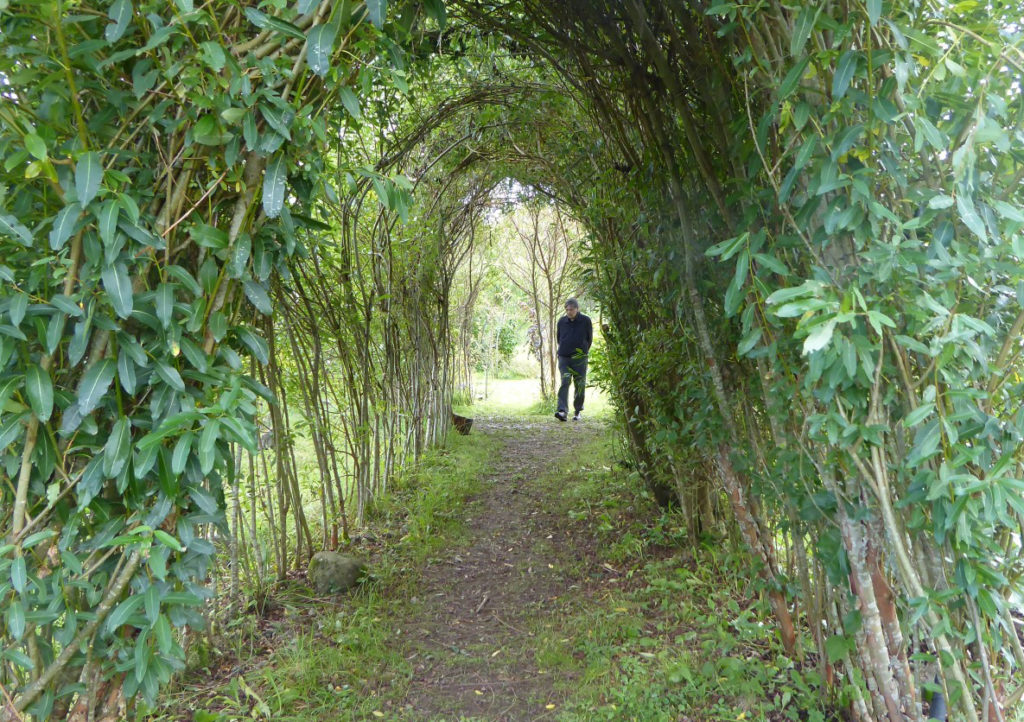
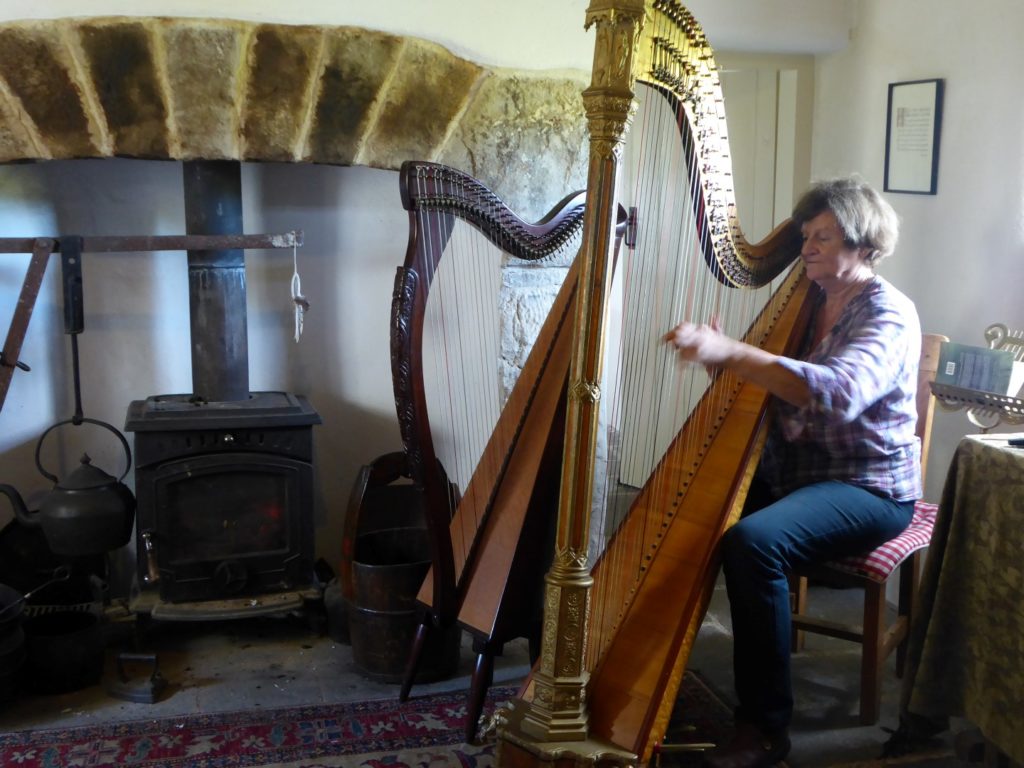
The dream community’s working together reminds me of the community-supported restoration and care of Drumskinny stone circle, and the evident communal care of two wonderful holy wells dedicated to St.Patrick, all of these in Northern Ireland, seen on the last days of our trip (along with two auspicious hawks!) The An Creágan Centre in the Sperrin Mountains, surrounded by Neolithic and Bronze-Age megaliths, combines a bogland biodiversity trail with various art projects and workshops. Ireland is filled with ancient stone monuments, holy wells, and rock art sites, but only some of them are protected, and this depends on the interest and care of the communities around them.
Actually, the dream’s theme of nature combined with art reminds me of the focus of all of our pilgrimages: searching for ancient and contemporary people’s ritual space in landscapes marked as sacred by their art, like the amazing Beaghmore stone circles in the northeast, amidst the stone circle-filled Sperrin Mountains, and the very different stone circles in the beautiful southwest, that other region of concentration of Bronze-Age circles. The three stone mandalas we made, one on a Cork beach and two on Donegal beaches, are examples of our own humble attempts to make a creative response to the beauty of the natural landscape around us. Yes, to be imbued with the pervasive presence of this combination of sacred nature honored with spirit-filled art and story is the whole reason we keep going back to Ireland!
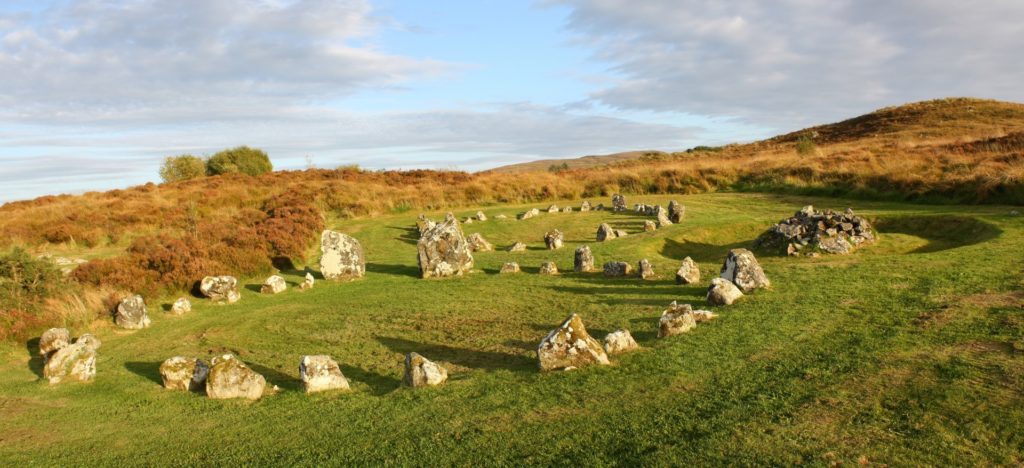
Landscape of the Goddess
We visited many places in the myth-filled landscape that we had hoped to see on this trip. We reached a spot from which to view the Bull, Cow, and Calf islands off the island of Dursey after riding in an old, rickety cable car across the churning strait from the Beara Peninsula and hiking to the highest point of the island. These islands feature in the Irish ancestral mythology of the Cailleach Beara as Shaper of the Land, the power of nature herself. The Hag of Beara is a unique geologic rock-form that is venerated (hag means wise elder.) Although mountains and cairns are named after her and legends told about her all over Ireland and Scotland, she’s Mother Goddess of my O’Driscoll ancestors in particular. She, as primal personification of all the wild forces of nature, is more ancient than the Tuatha Dé Danaan, the People of the Goddess Danu or Anu, who went underground in such places as the megalithic mounds and cairns and became the Sí (Shee) when the Milesian Celts arrived and defeated them. The Sí are the primary spirits of the land who manifested as the gods and goddesses, magical beings of an otherworld reality parallel to ours. The goddess, under various regional names, is the land. For a king to reign he had to marry her and care for her very well, so the land would remain fertile for the people. The Sí still appear to people as Fairies (not to be confused with cute little fairies). The Creideamh Sí or Fairy Faith is a pervasive folk healing tradition that has paralleled the Catholic faith through the centuries. Respect for, and fear of disturbing the Fairies is one reason why so many beautiful 5,000 year old ritual sites remain intact in Ireland.

Stone Circles
We journeyed to the foot of the Paps of Anu, the breasts of the Mother Goddess, a pair of rounded hills, each topped with an erect nipple-like Neolithic cairn. We could also see the Paps clearly in a cloudless sky from both of our favorite stone circles in the south. At one circle I drummed with sticks of gorse on the resonant central rock, calling, singing, crying to the ancestors for their wisdom. At the other I was very moved to see not only her lovely breasts, but also the mound of her belly, the reclining Earth Mother, her body the body of the sacred land. At Currabeha stone circle we found that the quartz boulder in the middle has similar earth energy-transmitting properties to the one in the middle of Gortanimil circle. The Gortanimil quartz was just as powerful as on our two previous visits to it, but standing on it barefoot, shaking, facing the vivid presence of the Mother of the Land, was incredible.
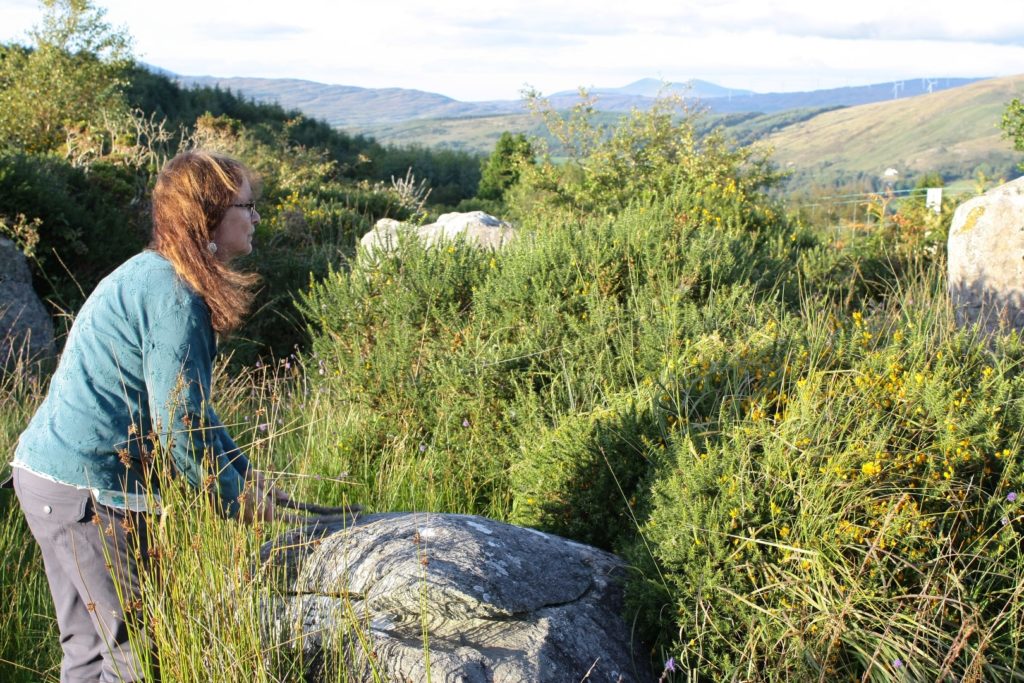
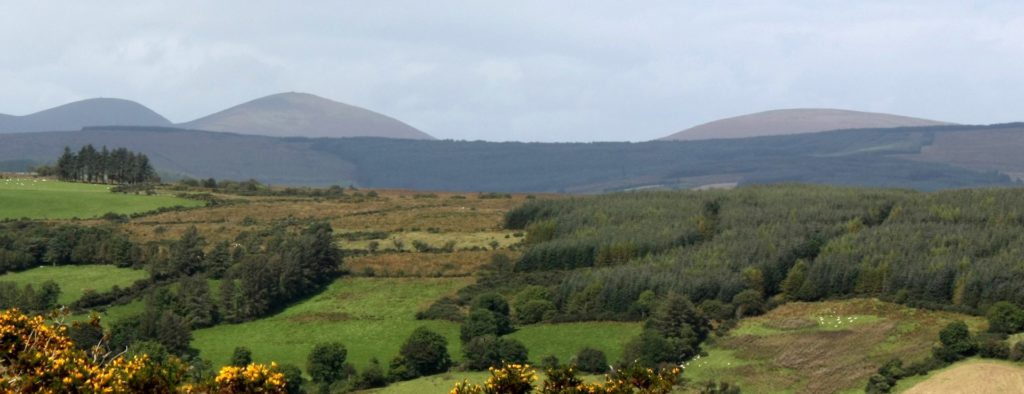
Often our attempts to find these ritual sites of the deep-time ancestors include hair-raising adventures. We had begun our search for stone circles in the south by following our GPS through innumerable, winding, one-car-wide country tracks until we heard the familiar “Navigate off road.” Which way? We stopped at a nearby house to inquire. The friendly woman who came to the door told us where to enter the impenetrable-looking hedgerow and moved her car, inviting us to park in her driveway. We missed the turn in the tangle of brambles and ended up in a cow path between pastures, bordered on both sides by an electric fence and hedges. David opened the electric gate and went up the hill, surprising a fox sunning himself, to look for the circle, while I walked to the end of the cow track to search that pasture for it. When I returned, the cows began crowding around me in the confined pathway, making a very loud ruckus. Suddenly I noticed a bull, nose ring, horns and all, amongst them about ten feet away. I was trapped!
I yelled for David who finally heard, came to the gate, and made enough noise himself to attract the herd away. It worked, and I scampered through the gate. We continued to search the hill for the circle while the cows continued to bellow. Giving up, we sneaked back to the gate by sticking close to the hedgerow, slinking along quietly, hoping the bull and cows wouldn’t spot us. When we got to the gate they saw us and started charging, but we got through the other electric gate quickly, discovered the missed turn, and finally found the Glanbrack stone circle, spending quiet time in it, or trying to, while the hungry cows continued on the other side of the hedgerow to make more noise than I have ever heard cows make. When we returned to our car the dear woman came out and invited us in for tea. She told us about another nearby stone circle and a walk, including three hundred steps, up steep Carrigfadda Hill. Driving away David said, “She was a Fairy, wasn’t she.” Over the years we have come to speak of the many good folks who have mysteriously appeared to guide our way as Fairies.
We were aware of Carrigfadda peak as sacred, but thought it too late in the day to look for it. However, driving back to our B&B we happened to see Carrigfadda Church, the place where the hike begins. The trail with its many steps was developed by the local community action group. So we climbed up amongst the purple heather and golden gorse to a vast, but misty view all around as the sun was lowering. Carrigfadda is in my ancestors’ territory, a pointed peak in the middle of a whole sacred landscape filled with Neolithic tombs and Bronze-Age stone circles. No fewer than eight stone circles and two stone rows surround it, and many of them would be visible from the peak on a clear day. Several of the circles are oriented towards this distinctive hill, and a portal tomb is aligned to the Winter Solstice sunrise over the peak.
Holy Wells
The climb up Grime Calli, (Bite of the Hag), to St.Colman’s holy well in the stony Burren landscape of Oughtmama (Breast of the High Pass) with our friend and guide, Pius Murray, was everything we could have wished for. We began our walk with an invocation to the Four Directions. On the way to the well Pius recited poems, I sang songs; there were some swallows flitting around that hadn’t yet migrated, so I sang The Swallow Song to them. We made rituals of honoring at this well with its two wind-sculpted trees, one hawthorn, one ash, in the otherwise treeless limestone escarpment. After climbing down the stone steps of this eye-healing well and praying for renewed vision of possibilities, we climbed back out and blessed each other with a bowl of the holy water saying, I am Spirit; You are Spirit. We sat together on the stone enclosure surrounding the well in silent meditation. Pius gave us each a sacred hazelnut to leave as an offering of gratitude, because, he said, if you take something (a cure) you must give something back.
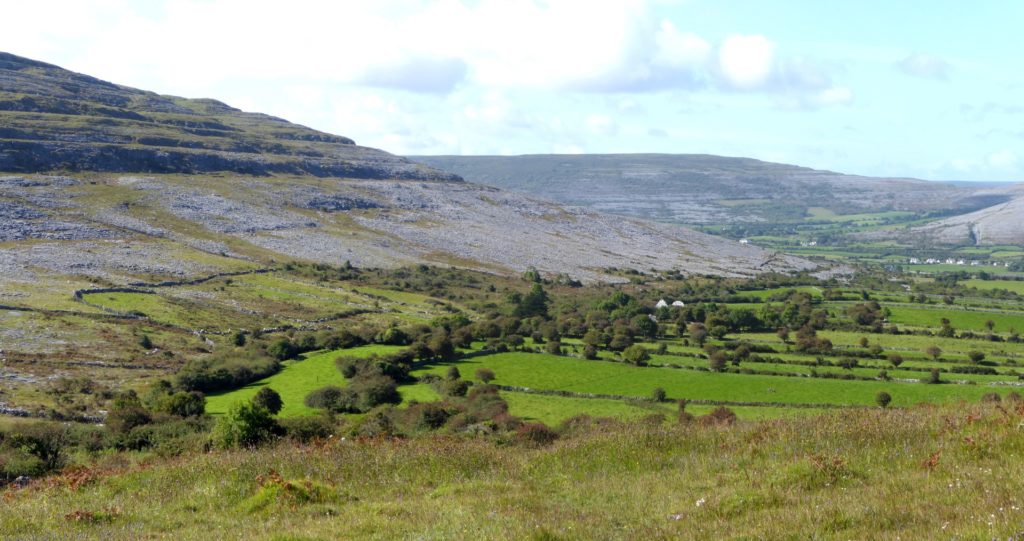
Then, standing on the hillside above the vast stretch of the green valley below, we made a ceremony to call to our deep-time Irish and Native American ancestors to ask for their guidance and wisdom in these hard times that we have inflicted upon the earth. Pius recited John O’Donohue’s lovely Beannacht (Blessing). Fr.John lived in the Burren, which he loved. I taught Pius the song and movements for the Choctaw-inspired Hashtali Elements Dance and the three of us danced it together, giving gratitude to Hashtali, Great Spirit, there on that windswept hillside. In his deep Irish voice Pius recited a poem in Gaelic that invited the presence of Spirit. We made prayers with pinches of the American Spirit tobacco that we brought him. Then we climbed back down and crossed the cow-populated pastures to see the three beautiful ruins of the 10th, 11th, and 12th century Oughtmama churches. Leaving the valley, we climbed over a gate with a “Beware of Bull” sign on it. Amidst heart-felt good-byes and vows to see each other again, we left Pius where we met him, at the little wooden, sod-roofed Hazel Mountain Chocolate Factory.
In the ancient Duhallow community there was once a great ritual landscape with four stations representing the four seasons and the four stages of the annual life cycle of the goddess of fertility. People are reviving pilgrimage to each seasonal location to celebrate the life of nature as personified by the goddess. We found two of these four cross-quarter pilgrimage sites, one, a female saint’s holy well for Lughnasa, Fall Harvest, the other, Coiscéim na Caillí (the footstep of the Hag), the setting for Samhain, the beginning of Winter. As often happens with us, despite lots of searching we couldn’t find the revered holy wells for Imbolc or Bealtaine. Ah, it was not the right time of year to visit those! Sean O’Duinn, a monk at Glenstal Abbey, describes these Duhallow sites in his book In Search of the Awesome Mystery about the continuity of the three streams of spirituality in Ireland — Megalithic, Celtic, and Christian.
Along with several other holy wells, themselves all community-created works of art, that we did find, we experienced three wonderfully complete wells: Tubrid, Well of St.Brigid, in the south, and the two wells dedicated to St.Patrick in the north. Here’s my definition of complete: There is an enclosure defining sacred space, which is entered through a small gate. There is a path around which to circumnambulate the well (sunwise three times), an altar at which to make offerings, and a bench to sit upon in the profound peace. There is a sacred tree. Sometimes this is a Fairy hawthorn tree. At St.Patrick’s well in Magherakeel there were oak, hazel, ash, and full-berried hawthorn and holly trees. On the walk to this well we passed elderberry and alder trees, laden with fruits, so this well with its many sacred trees was especially full of vibrant life. Complete means there is cold, clear, water issuing from within a mountain or bubbling up in a pool of springs at which to pray for healing of self, for loved ones, and for a renewed relationship to all our precious waters. Here, I poured the purifying water, which dripped through a stone funnel into the stone chamber, over my head repeatedly with the pot kindly provided, under the gaze of the very lovely white statue of St.Patrick.
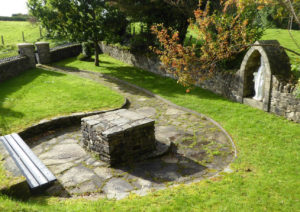
At St.Patrick’s well in Belcoo, I stood, albeit briefly, in the extremely cold pool of bubbling springs, as per written instructions for the healing of abdominal symptoms, which I happened to need, and which seems to have worked! This was soon after having stood, on impulse, in the cold spring waters of the Shannon Pot, rising up from the karst cave system below, the legendary source of the Shannon River, named after Sionna, herself a Goddess.
Rock Art
Our field trip to see ancient rock art at Derrynablaha (Little Oak Wood of the Flowers) in County Kerry with archeologist Aoibheann Lambe (pronounced “Even”) and two of our friends from home was a wonderful adventure of climbing up the desolate rocky mountainside above an isolated, mystical green valley, accessible only by mountain passes, to try to see boulders decorated with ancient cup and ring combinations, before the fog coming over the mountain enveloped us. But we were soon enclosed in the white mist, which added to the magic and mystery of this secret, sacred glen. As darkness descended we were finally able to see the art on a few of the forty-some decorated boulders, illuminated by Aoibheann’s light. Where before there had been only rock with some tangible texture, the four-thousand year old carvings suddenly appeared, as if the ancient people themselves were now gathered around us. This was a good example of Jung’s essential combination of Instinct (climbing up the rough blanket bog) and Image. We found more rock art later on the Giant’s Grave wedge tomb at Cavan Burren Park. Ireland is full of rock art, which is only now starting to be appreciated as more discoveries are made, by people like Aoibheann.
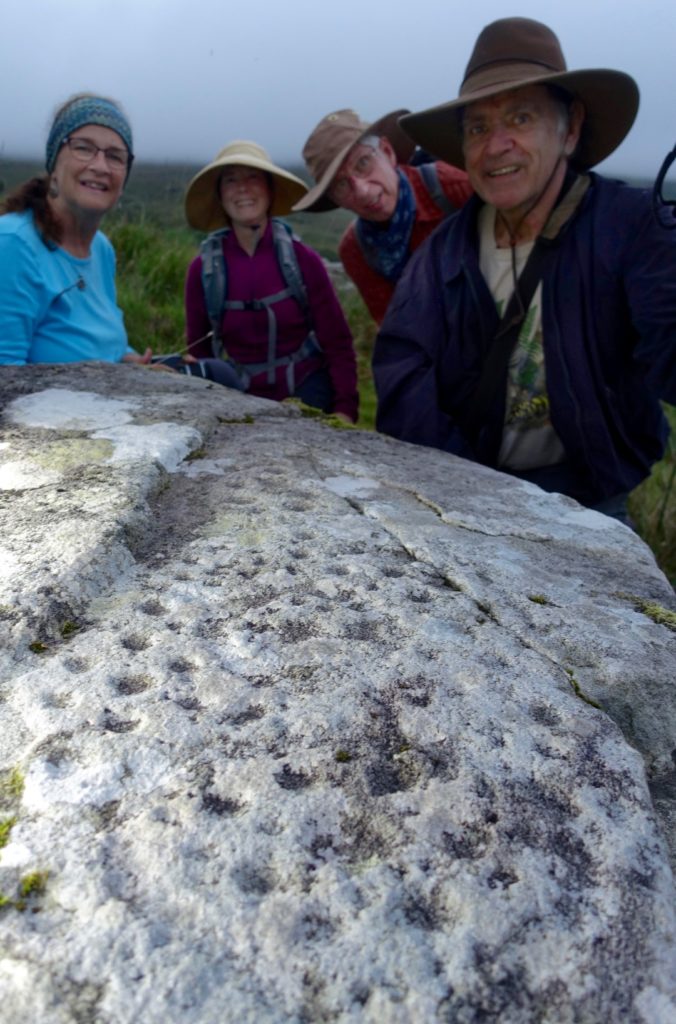
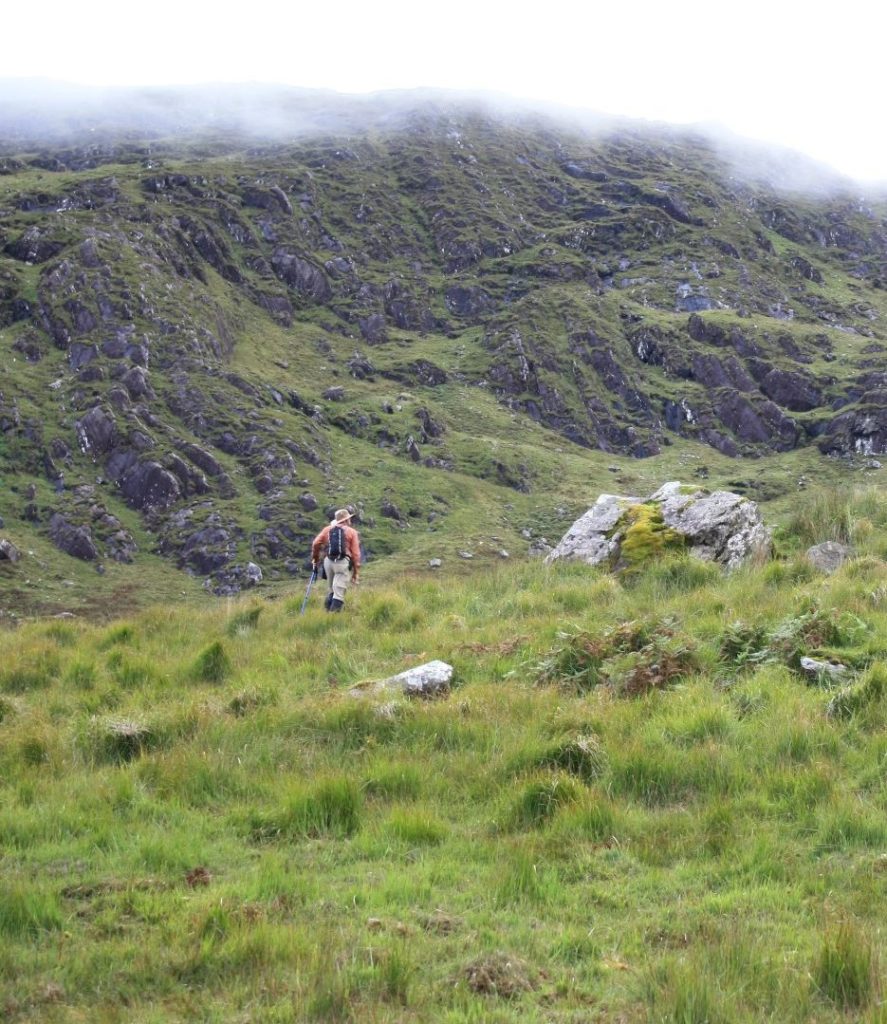
Hill Walks
Ireland is threaded throughout with open-access community-created trails and wonderful hill walks. We took several of these beautiful coastal walks on the Dingle Peninsula. My favorite hike was to the top of Sybil Head, that strangely shaped cliff at the mouth of Ferriter’s Cove that we have admired on other trips. It was exhilarating to be up there only inches away from the sheer face of the cliff dropping straight down a couple hundred feet to the ocean below. We were amazed to see that we were up there higher than the upsweeping Three Sisters and out on the ocean side of them, up even with Ballydavid Head rising beyond, which we had climbed on a previous trip. The view up there of the high crags of Sybil and the Blasket Islands beyond was gorgeous. Sybil, of course, comes with her own legend regarding that Ferriter guy, as do most of the features of the Irish landscape, as told in the Dinnseanchas, the Stories of Place. Knowing these shared stories creates a feeling of kinship with the Irish people and with the land. The mountain is a being with a story, not just a mountain.
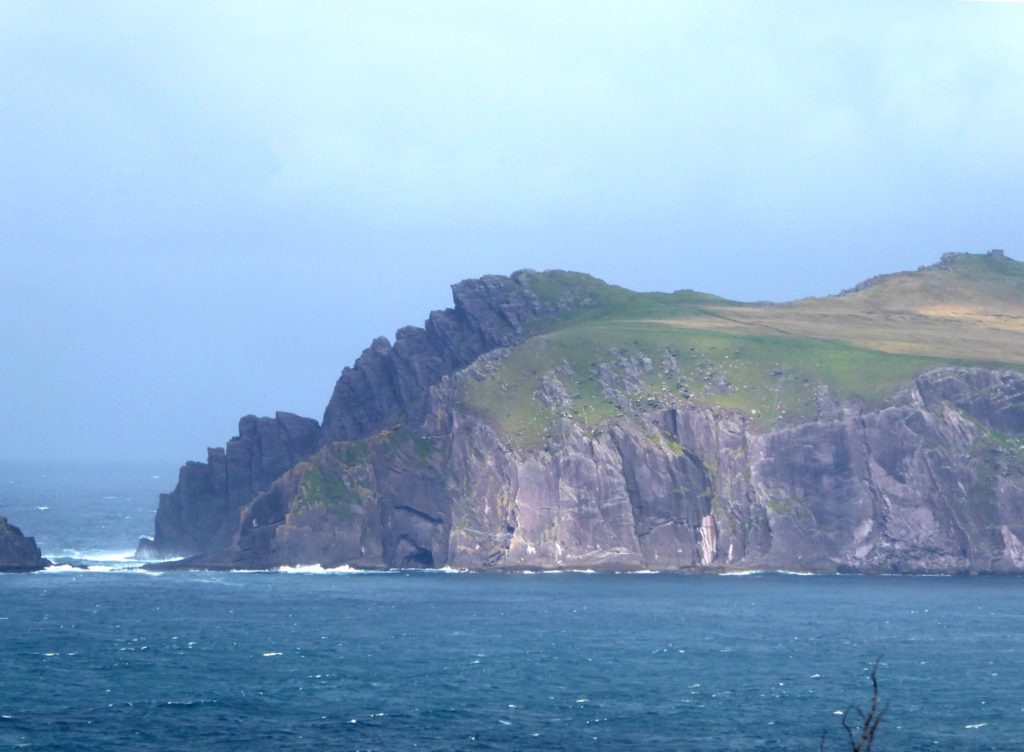
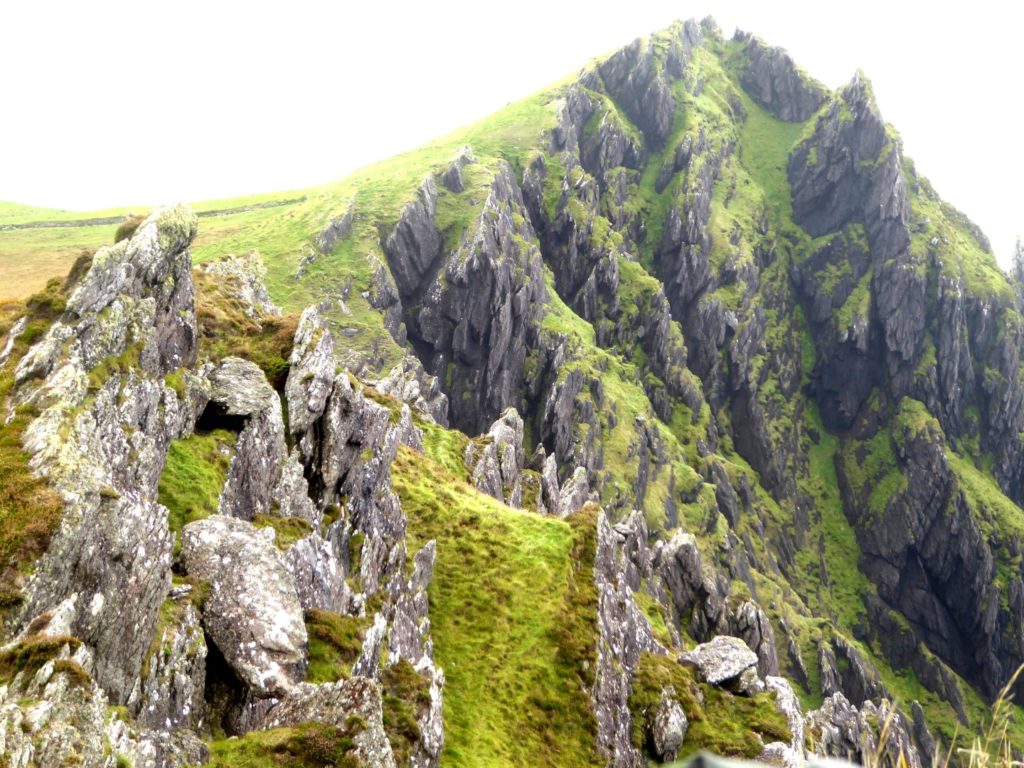
In the Burren the hike along the turlough (a seasonally vanishing lake) and the climb up the turbaned swirl of that iconic limestone hill, Mullaghmore (Great Summit), even though we didn’t make it to the top, with heavy rain coming in, was very exciting in its challenge and in its beauty. We climbed the next day through the varying habitats, limestone pavement, flower-filled grasslands, and hazel woodlands, of the Lough Avalla Farm loop trail, with its ever-changing views of Mullaghmore. A small sign at the trailhead said that the walking sticks provided were for the using and for the keeping, if you wanted. We were charmed by the trail’s lovingly created transitional features, stone stiles and wooden gates, its steep places thoughtfully furnished with stone steps and hazel railings. At the high point of the trail the view down on Mullaghmore was spectacular. We sat up there quite a while in the lovely weather, sharing those glorious heights with two cliff-hugging donkeys, a herd of feral goats, and a women’s hill-walking group from Wexford. One of the women told us that there would be goat cheese sold down at the lake house below. Back down from the trail we saw a little sign that said, “Tea and coffee two minutes ahead.” How could we resist?
In the stone cottage, Harry Jeuken provided us with tea, apple pie with cream, and brownies, made by Eileen, out of the goodness of his heart and his intent to serve those who arrive at his doorstep from the walk. He and his five children had constructed the trail, which was his gift to the community. When I inquired he said, yes, his daughter used to make goat cheese in the summers to sell there, but she was off at college learning veterinary medicine. He said he misses the cheese-making, “but that’s ok.” Several times he told us about challenges and changes and added gently, “and that’s ok.” Each time he said this I got a feeling of complete serenity that seemed like the mountain itself coming through him. I have never been with someone who seemed so completely at one with his landscape that it was hard to tell one from the other. Harry wouldn’t take any money for the treats, but gratefully accepted a donation. When we told him how much we appreciated the artfully created gates and stiles, he seemed pleased and said this, too, was a mutuality of giving.

The Burren grasslands are a whole community conservation story in themselves. The limestone makes for rich grassy meadows. But it is only in naturally fertilized pasture that the wildflowers grow in such profusion. Therefore, many of the farmers are trying to bring back the old ways of pasturing. With the early fall flowers come butterflies, and we saw many: Red Admirals, Small Tortoiseshells, Speckled Woods, colorful Peacocks, and orange Wall Browns.
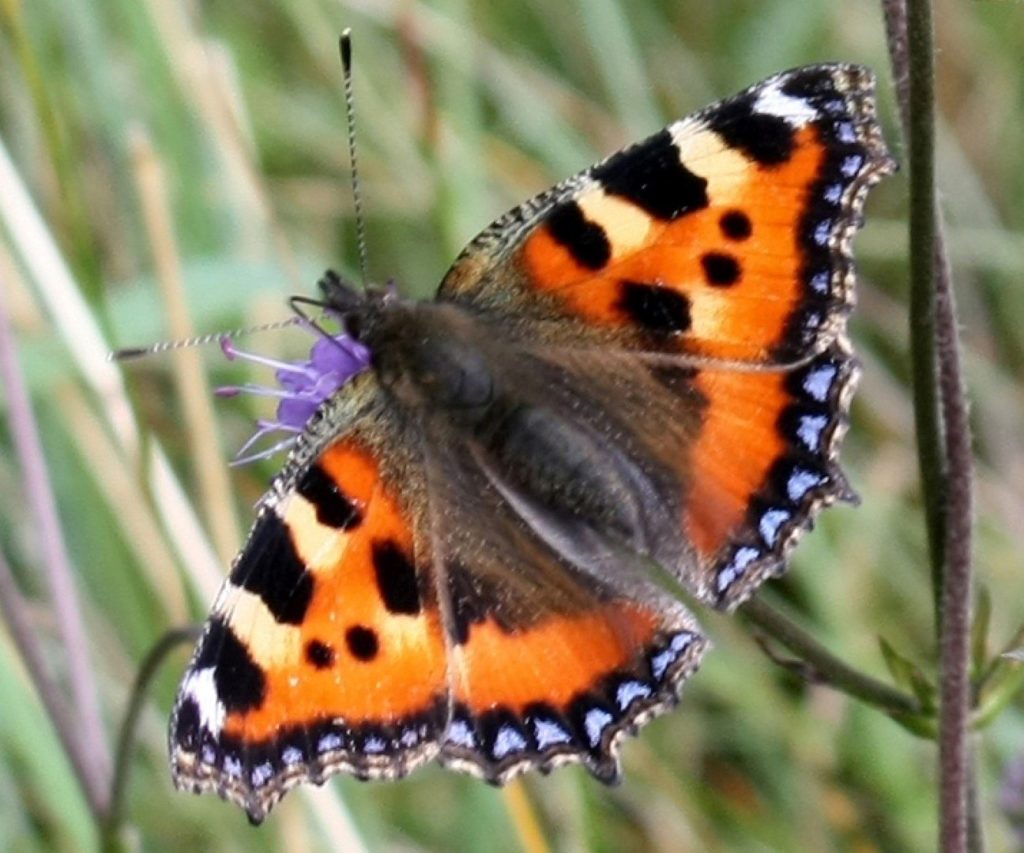
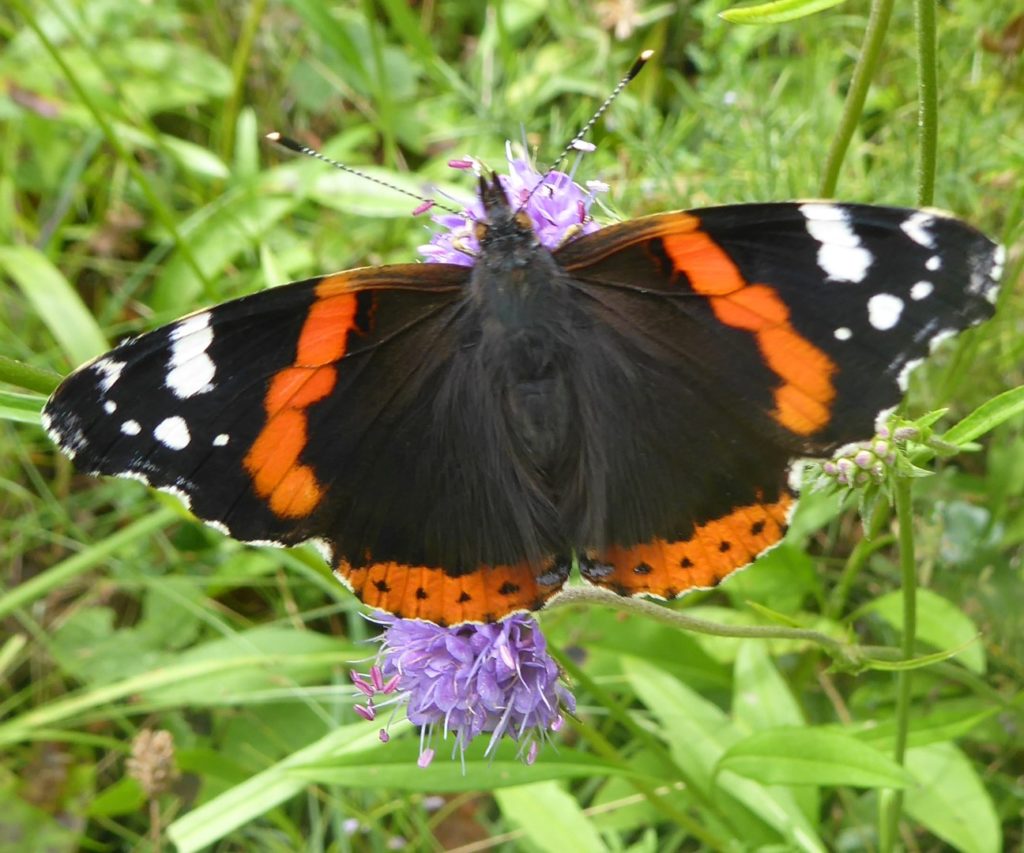

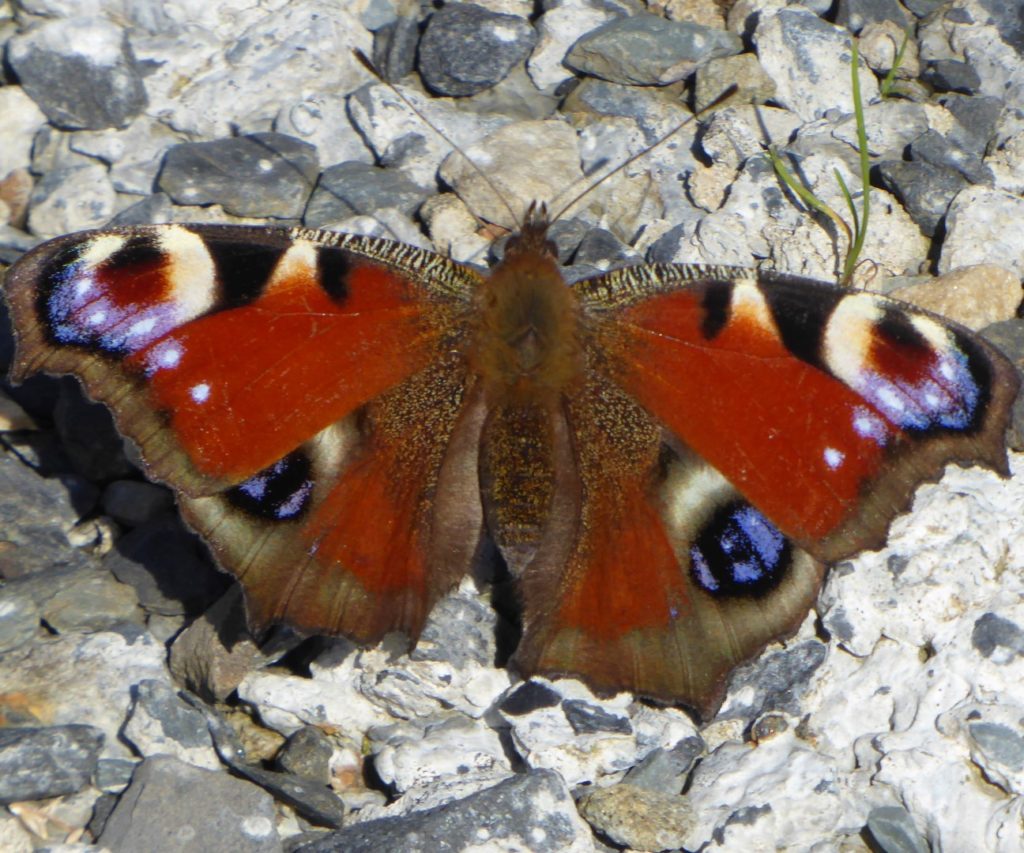
Walking back down the stony farm road towards our car, we suddenly became aware of a shadowy figure walking along beside us. Turning, I saw it was a young woman walking bent over in the dark woods beside the road. Oh, a man, too, was walking along slowly and stooping down. I asked them what they were doing. They said, “Gathering hazelnuts.” Ah, so of course we began picking some nuts from the trees beside the road to leave as offerings at the holy wells we would visit, as Pius had taught us. I also hoped to bring home nine of them, as that is the number of sacred hazel trees surrounding the Well of Connla, the mythical source of the Boyne River, the river of the Goddess Boann, which drop their kernels of wisdom into its waters.
Later in the trip we walked for a couple of miles on the new community-created loop trail at the foot of the iconic prow of Ben Bulben, gazing up in wonder at the amazing crenellations along the whole expansive top of it, looming over Yeats’s beloved Sligo.
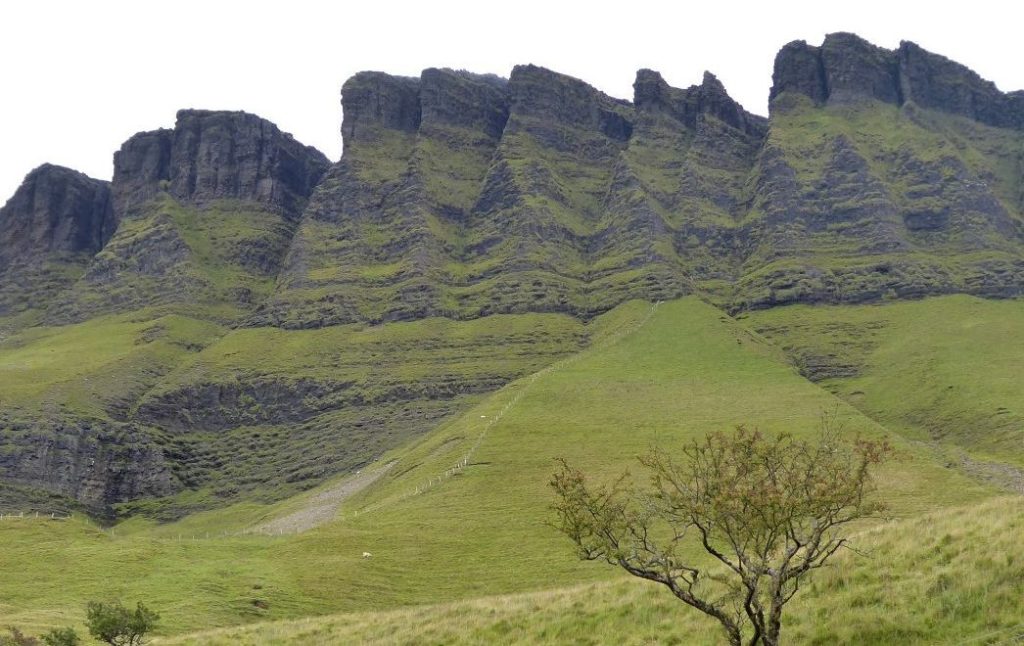
Driving through the beautiful green Glencar Valley on the other side of Ben Bulben, bordered by miles of equally spectacular mountain formations, we arrived at another stunning limestone region, the Cavan Burren, with caves below and high mountains of fragile boglands and montane heath above. We enjoyed a tour of the fascinating calcite formations and underground river in the Marble Arch Caves. A hike to the top of Gortmaconnel Rock gave us a panoramic view of this vast, incredibly varied karst landscape full of Neolithic stone creations. In this large region, many different villages and communities have banded together to honor their unique geology and beautiful natural habitats full of ancient megaliths, and have created Marble Arch Caves Global Geopark.
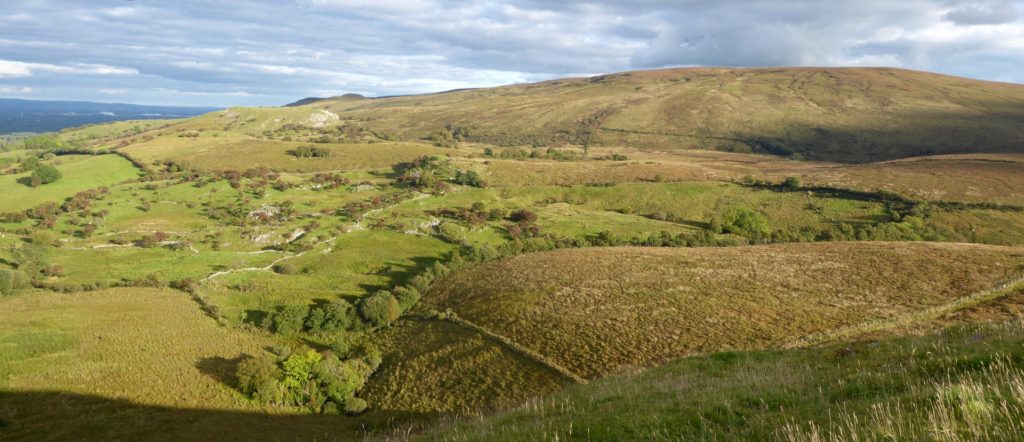
On a clear, bright blue day in Donegal we drove through a mountain pass and miles of vast empty blanket bog looking for a coastal stone village abandoned during the Great Famine. When we neared the ocean, we parked the car on the side of the small road above a rushing stream and walked the remaining mile on Sli Colmcille (St.Columba’s Way), to the ghostly remains of An Port on the edge of the Atlantic. Colmcille, St.Columba, is the third patron saint of Ireland after Patrick and Brigid, and this Sli is part of the pilgrim’s path to honor him. Sli Colmcille is also a section of the International Appalachian Trail, the inspired endeavor of many communities along the Atlantic seaboard of Europe to acknowledge that we were once connected in the continent of Pangea, and the underlying geology still joins us together.
We noticed that the beach at An Port was made of black and white cobbles. As it was the day before the Autumn Equinox, they seemed symbolic of the balance of darkness and light, so we made a mandala, one side black, the other white, a man-like face poised between them. We then continued to hike the IAT up the headland, a continuous upward stony “green road” with many switchbacks, through miles more of vast blanket bog, some vistas grey-green with grasses, some chartreuse green with mosses, others orange with the fall color of bracken fern, or pink with the haze of heather. I shouldn’t say this vastness was empty, as it was populated with a few sheep here and there. One group of sheep had each right horn painted bright red. Not arriving at a place where we could look down on Glencolmcille village (with its many decorated cross pillars) as we’d hoped, we finally turned to walk back down to An Port, dark clouds gathering behind us. It began to thunder. At each clap the sheep would jump up and hop forward. We were the tallest things for miles around, so it became a little scary. It began pouring, but then the rain turned to pinging, stinging hail for ten or fifteen minutes. The thunder ceased, the rain continued, but ahead a beautiful rainbow emerged, rising right up between the cliffs from one of the craggy rocks in the harbor below. Then the rain stopped and the sky became all blue with puffy white clouds again. We had many days of such minute by minute changes of Irish weather on this trip!
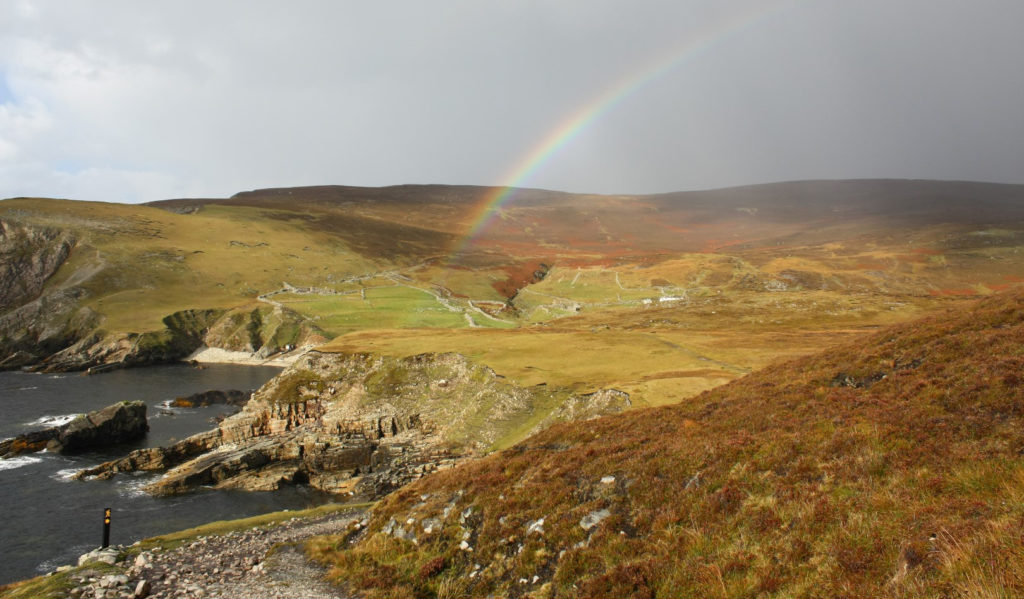
On the Equinox we were exploring further up the coast of Donegal, after passing through villages overcrowded with holiday cottages, when we suddenly looked down upon a desolate beach populated only by vast expanses of very large round white stones, looking like millions of bald pates rolled up on the shore. We parked above and walked down the winding boreen past sheep in fields surrounded by beautifully unique walls of round stones. Walking on the beach amongst the giant white balls we saw that between them were smaller black, white, and colored cobbles. We chose one of the flatter boulders and made on it a Celtic cross, with a circle of colored stones enclosing a cross of black and white ones, to continue the theme of balance. As this was nearing the end of our journey, making this Celtic cross seemed like a symbolic seal on our pilgrimage, in gratitude to the ancestors and to the good spirits of this Spirit-infused land. Making it was also an act of affirmation of our dream of an honored Earth and our hope that we will be around to see it happen. And of our desire to return with a story for our community that inspires a vision of all our lands as sacred, a vision so luminously embodied in Ireland, Eire, Land of the Goddess Eriu.

Note: If you liked these Ireland reflections you might also enjoy reading about the adventures that ensued when I broke my ankle on our first pilgrimage to Ireland, called Ireland on One Foot. Or this story about pilgrimage to the sacred sites of Irish St. Gobnait.
Text © 2017 Betty Lou Chaika. Photos © Betty Lou and David Chaika.
Diantha Rau
In the stones my soul comes home, in the green my heart remembers, in the waters I move as I must, in your words I am taken back to the earth-ways that make me whole.
Betty Lou
Diantha, through the voice of your songs, through the sounds of your flute, may we sing together to Mother Earth.
ZubinNur
Thank you for this blog too… I’ve only just got around to reading it. I just love Ireland and you have captured the flavour so well in your words and with the photos, … Thanks for all your work for our planet and for all of our relations 💛🙌💛
Betty Lou Chaika
Thank you, ZubinNur, for loving Ireland! She has so much to teach us about how to be in a spirit-imbued and well-storied landscape. And thanks for your work for our beautiful Earth, too.
Carl Hyatt
Thank you for your honoring and for sharing the wealth of your travels!
Betty Lou Chaika
Carl, hi! And blessings upon all of your work in sharing the intimate relationship between the community of people and other life forms of this sacred Earth.